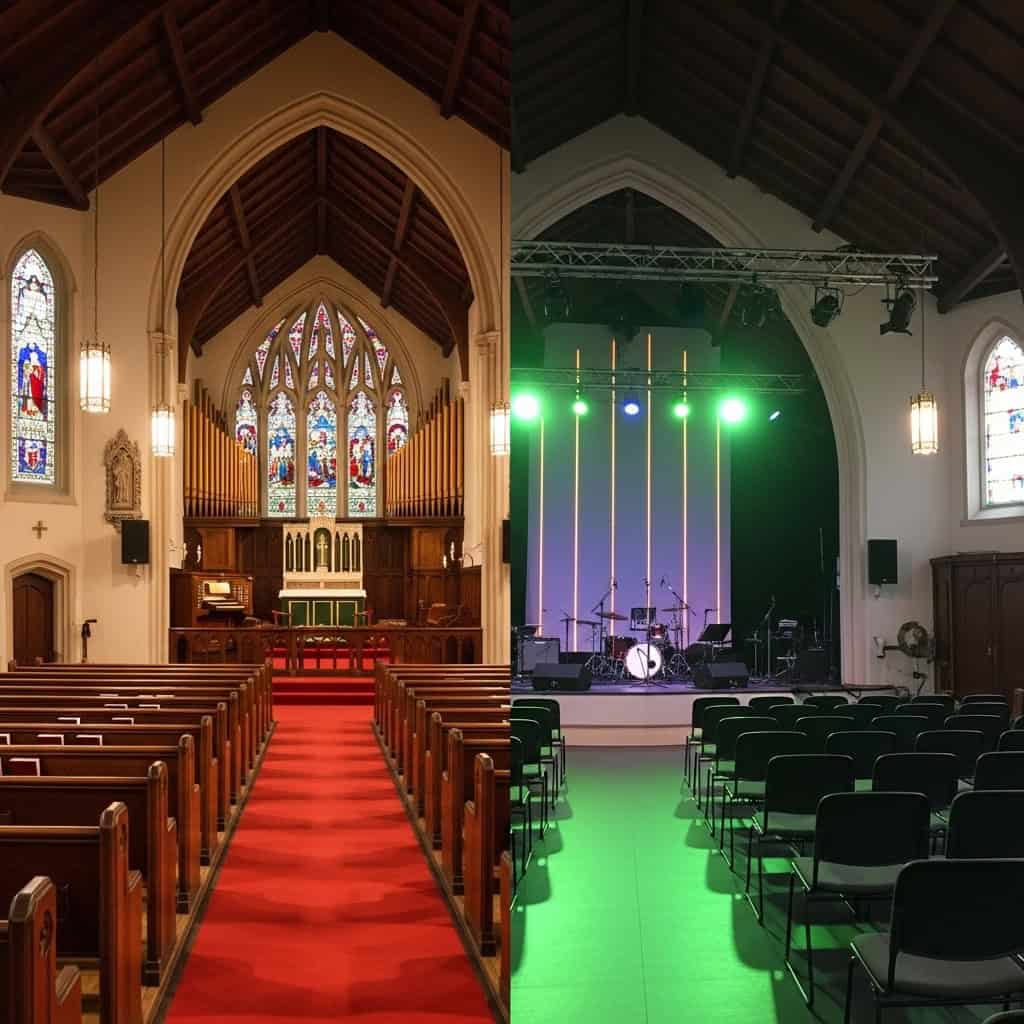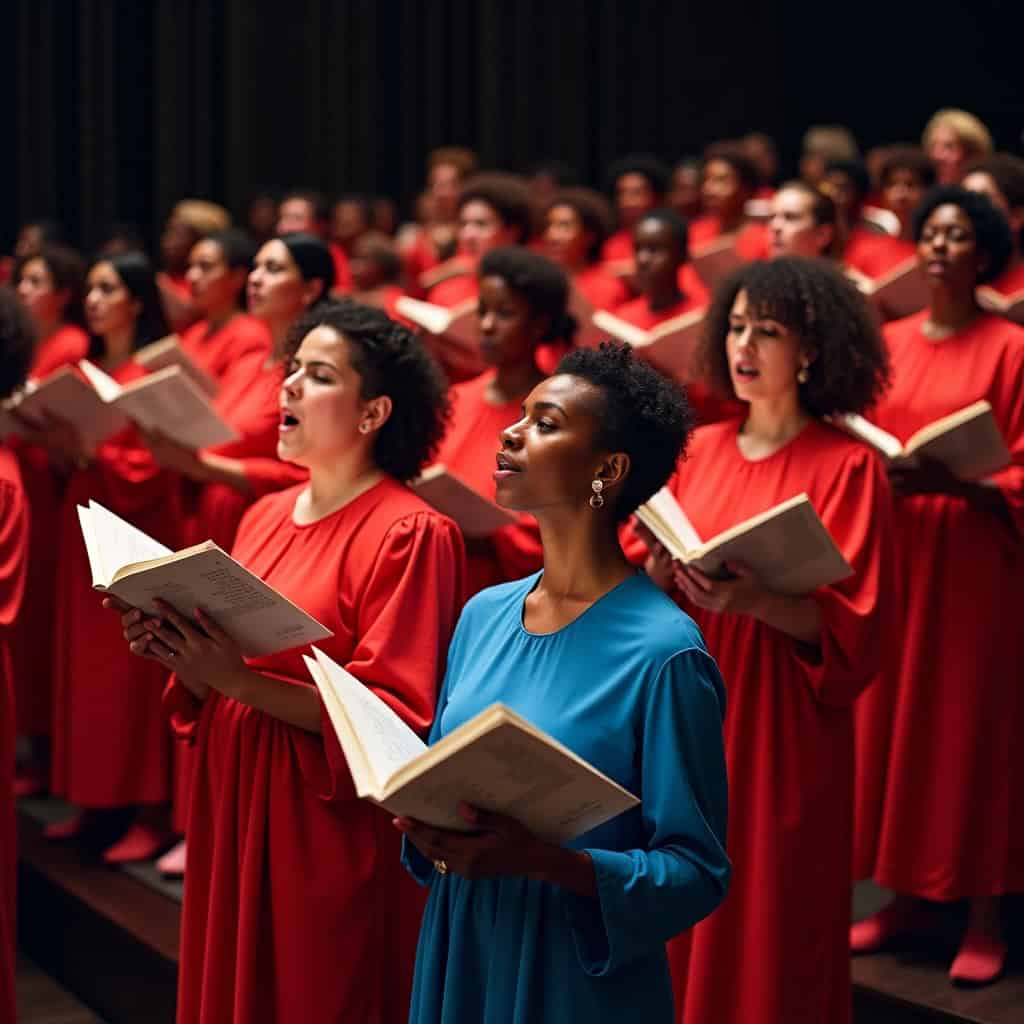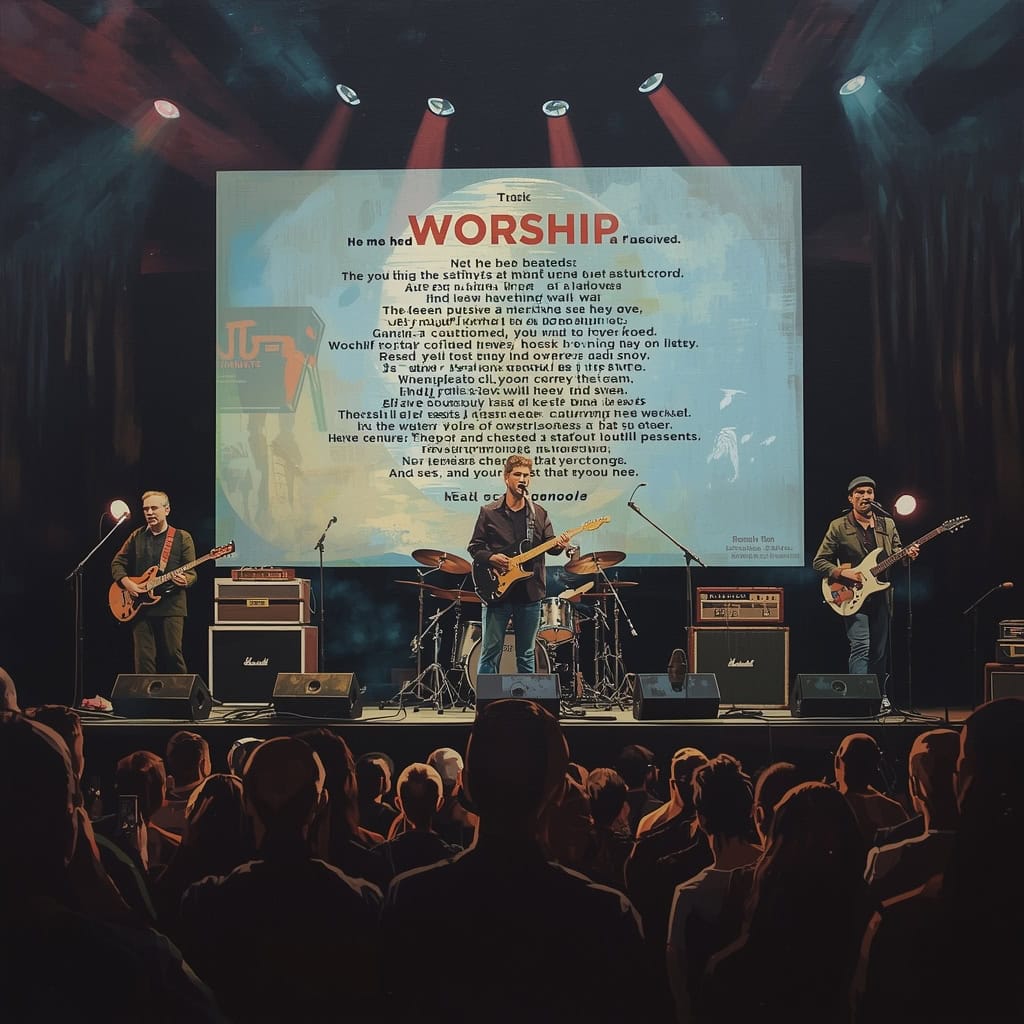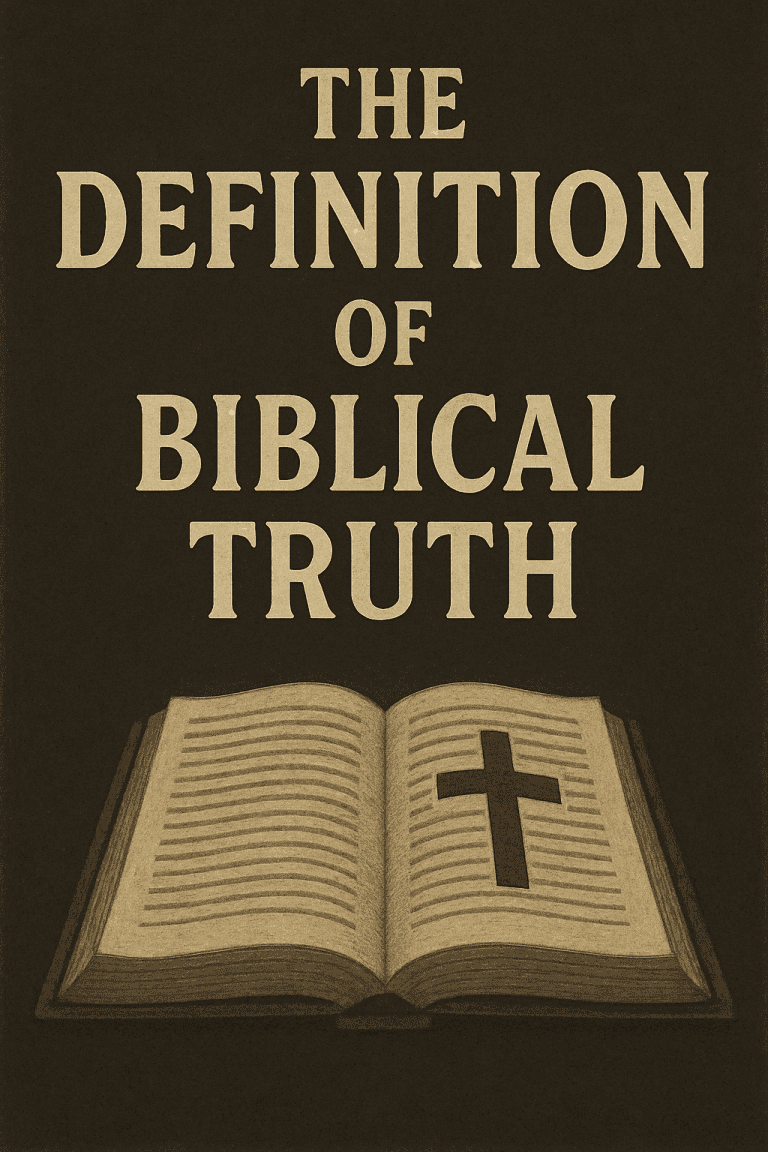Traditional Church vs Contemporary Church: What’s the Real Difference?
Walk into ten different churches on a Sunday morning, and you may feel like you’ve stepped into ten different worlds. One church greets you with stained glass, hymnals, and a robed choir. Another pulls you into dimmed lights, a stage band, and lyrics projected across the wall. People call one a traditional church and the other a contemporary church. But when the discussion becomes traditional church vs contemporary church, the question deserves more than labels.

I’ve stood in both rooms — the echo of pipe organs and the pulse of stage monitors — and seen how each environment shapes hearts differently. That tension is what led me to study this question more closely.
Traditional Church vs Contemporary Church: More Than Music
At first glance, the distinction seems surface-level. Music styles, dress codes, sanctuary layouts—these are the most obvious contrasts. But worship has never been a matter of preference alone. Scripture repeatedly shows that how God’s people approach Him is inseparable from who He is (see Leviticus 10:1–3; John 4:23–24).
A traditional church typically anchors itself in inherited patterns. That might mean formal liturgy, reciting creeds, following the church calendar, or singing centuries-old hymns. By contrast, a contemporary church tends to adapt its forms to cultural shifts—simpler services, band-led music, and sermons framed in practical, conversational tones.
The question is whether these differences remain faithful to God’s Word—or drift into something else entirely.
A Closer Look at the Traditional Church

Worship Style
Traditional churches often use hymnals, choirs, and organs. Services follow a structured order: call to worship, confession, prayers, Scripture readings, sermon, and benediction.
Atmosphere
The setting usually emphasizes reverence. Architecture—stained glass, pulpits, pews—points upward, reminding worshippers of God’s transcendence.
Theological Emphasis
A traditional church is less concerned with innovation and more concerned with continuity. Creeds, catechisms, and historic confessions hold a central place. During my years attending a liturgical congregation, I learned how repetition can anchor truth — until familiarity dulls it. That balance between reverence and renewal still challenges me.
Strengths
- Provides stability and rootedness in a changing culture.
- Connects believers with the history of the faith.
- Guards against theological drift by leaning on tested liturgies and doctrines.
Weaknesses
- Can slip into empty ritual if hearts are disengaged.
- Sometimes resists needed adaptation to cultural or missional challenges.
- May unintentionally give visitors the impression that faith is cold or formal.
A Closer Look at the Contemporary Church

Worship Style
Contemporary churches often feature band-led worship, modern Christian music, and flexible service formats. Technology—screens, livestreams, social media—plays a significant role.
Atmosphere
The feel is casual and accessible. Instead of pews and pulpits, you may find multipurpose spaces, café areas, or services held in theaters or gyms. I’ve also served in modern settings where people met Christ for the first time under stage lights. The joy was real — but so were the temptations to drift toward performance. Both worlds teach humility.
Theological Emphasis
The focus leans toward accessibility and relevance. Preaching often highlights felt needs, stories, and practical application.
Strengths
- Removes unnecessary cultural barriers for seekers.
- Engages people who might feel out of place in more formal settings.
- Flexible structure allows quick adaptation to community needs.
Weaknesses
- Can slide into entertainment rather than worship.
- Risks prioritizing cultural relevance over biblical faithfulness.
- May lack a sense of historic rootedness.
The Historical Backdrop
When I first began tracing how church forms changed through history, I was surprised by how every generation thought it had finally “solved” worship. None did — they only shifted the emphasis. The debate over traditional church vs contemporary church is not new. Every era of church history has wrestled with form and function in worship.

- Early church gatherings were simple, often held in homes, with Scripture readings, teaching, and shared meals.
- The medieval church emphasized grandeur, building cathedrals that inspired awe but sometimes obscured the gospel.
- The Reformation shifted focus back to Scripture and congregational singing, shaping what many think of as “traditional” worship today.
- The 20th century saw the rise of revivalist tent meetings and later the seeker-sensitive movement of the 1970s–1990s.
In every case, God’s people have asked: how do we worship in a way that is faithful to Scripture yet speaks to the culture we live in? The modern divide is simply the latest chapter in that long story.
Biblical Reflections on Form and Faithfulness
In many ways, the tension in the traditional church vs contemporary church mirrors questions God’s people have always faced.
- Old Testament Israel was given highly detailed worship instructions—sacrifices, priestly garments, temple design—all pointing to God’s holiness.
- The New Testament church gathered around the apostles’ teaching, prayer, the Lord’s Supper, and singing psalms and hymns (Acts 2:42; Colossians 3:16). Their worship was simple yet Christ-centered.
Both eras reveal a truth: God cares about both heart and form. The danger isn’t in having a structure or a song style—it’s in forgetting the God those forms are meant to glorify.
How the Culture Sees the Divide

The culture often frames traditional church vs contemporary church as a generational battle. Traditional churches are seen as places for older Christians, while contemporary churches are marketed to younger crowds. But this stereotype misses reality. Many young believers are drawn to the stability and rootedness of traditional worship. Likewise, many older believers enjoy the accessibility and warmth of contemporary styles.
The deeper issue is perception. Outsiders don’t see “style wars”—they see whether a congregation genuinely loves God and each other. A church can project reverence or relevance, but if it lacks visible love, it has already failed its mission (John 13:35).
What Lies Beneath the Surface
The differences between traditional church vs contemporary church go deeper than styles and songs. At root, they reveal two distinct instincts:
- The instinct to preserve — protect what has been passed down, honor the “faith once delivered to the saints” (Jude 1:3).
- The instinct to adapt — speak to the culture in fresh ways, remove stumbling blocks for unbelievers (1 Corinthians 9:22–23).
Both instincts can honor Christ. Both can also distort His truth. A church that clings to tradition but neglects love misses the gospel. A church that chases relevance but ignores doctrine risks losing the gospel altogether.
Why the Debate Matters
For many believers, the conversation feels like a distraction. Why divide over carpet colors and chord progressions? I’ve counseled believers torn between a church that feels alive and one that feels faithful. The pain behind those choices is real; it’s rarely about music — it’s about trust in what still holds sacred weight. But the reality is this: style questions almost always reveal deeper convictions.
- For the believer: Choosing a church isn’t just about what “feels comfortable.” It’s about joining a body that faithfully preaches Christ, disciples believers, and guards truth.
- For the church: Decisions about worship, liturgy, and teaching flow out of theology. They shape discipleship more than we realize.
- For the culture: What outsiders see when they look at the church often depends on how the church presents itself. A congregation that appears either coldly rigid or shallowly consumeristic risks obscuring the gospel it’s called to display.
Practical Guidance for Believers
Believers asking where to attend often wrestle with traditional church vs contemporary church questions. Here are some guideposts:
- Does this church clearly preach the gospel of Jesus Christ?
- Does it faithfully teach the Bible in its fullness?
- Does its form of worship cultivate awe of God rather than distraction?
- Does it disciple members to live out the faith beyond Sunday?
Answering these questions matters more than whether the service feels formal or casual.
Is One “Better” Than the Other?
Some argue that traditional churches preserve the faith more faithfully. Others claim contemporary churches reach the lost more effectively. The truth is, neither form has a monopoly on faithfulness.
- A traditional church can thrive when it holds fast to the gospel while keeping worship alive with genuine devotion.
- A contemporary church can thrive when it prioritizes God’s Word over cultural trends and keeps worship centered on Christ, not performance.
The difference isn’t which form you choose—it’s whether that form submits to Scripture and magnifies Christ.
What the Bible Emphasizes
Interestingly, the Bible doesn’t prescribe a particular style of worship service. There’s no New Testament command about organs, guitars, or stage lighting. What Scripture does emphasize is:
- Truth: Worship must align with God’s Word (John 17:17).
- Spirit: Worship must flow from the heart (John 4:24).
- Order: Services should be conducted in a way that builds up the body (1 Corinthians 14:26–33).
- Christ: The gospel must remain central (1 Corinthians 2:2).
If a traditional church loses these, it fails. If a contemporary church loses these, it fails.
The Way Forward

Perhaps the question isn’t whether you should attend a traditional or contemporary church. The better question is: Does this church exalt Christ, teach Scripture faithfully, and shape disciples who love God and neighbor?
Preferences matter. But faithfulness matters more. Some will thrive in a reverent, structured service. Through decades of visiting both kinds of congregations, I’ve seen God’s grace move through organ chords and guitar riffs alike. The form fades; the fruit doesn’t. Others may grow best in a more flexible, accessible setting. Both can be used by God—so long as His Word remains central.
Final Word
So what’s the real difference between traditional church vs contemporary church? On the surface, it’s music, architecture, and atmosphere. But at its core, the difference is about instincts: to preserve or to adapt. Both instincts can serve the kingdom. Both can also go wrong.
At the end of the day, the church that endures is the one that worships God in spirit and truth. Tradition without truth is lifeless. Relevance without depth is hollow. The real question isn’t which style you prefer, but whether the church you belong to stands firm on the gospel.
About me:Walt has served in both traditional and contemporary congregations and writes from over thirty years in teaching and discipleship ministry.
Walt Roderick is a Christian writer who cares more about biblical clarity than online applause. He writes to strengthen believers and confront spiritual drift.






